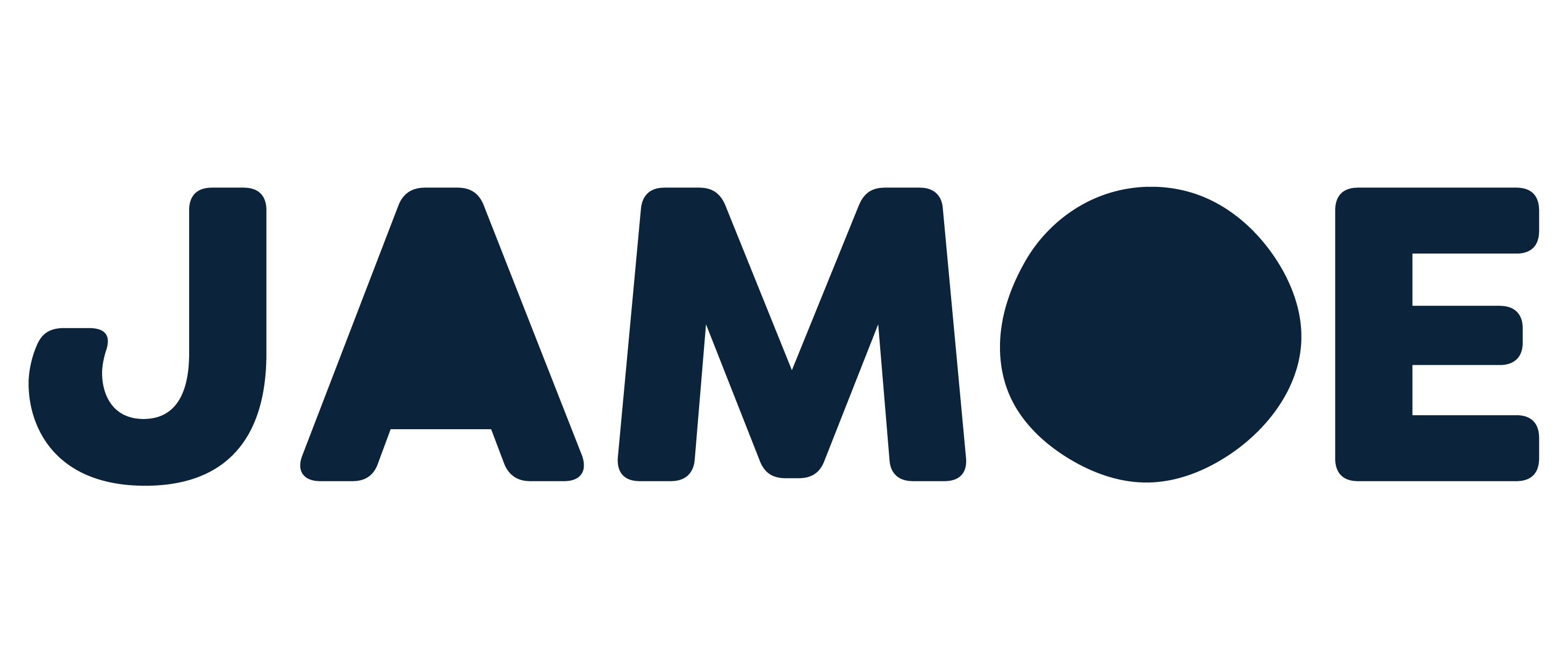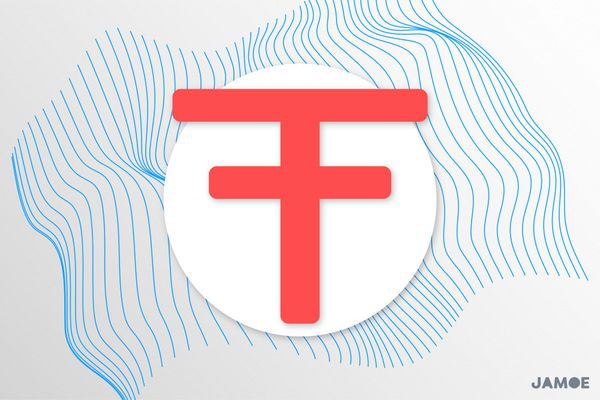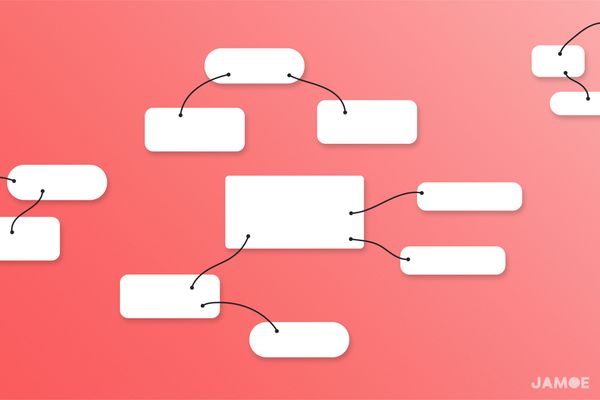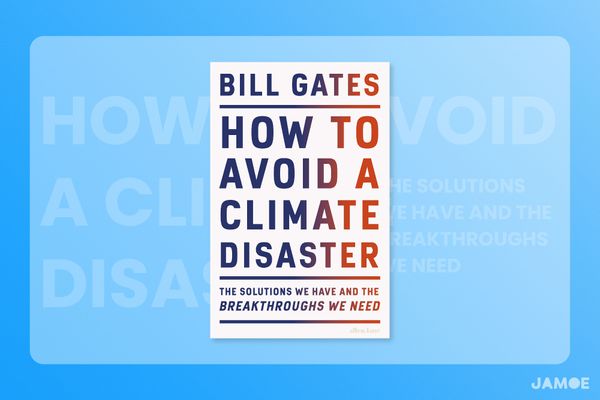Think Deeper: Upgrade your HQ&A Notes with Up, Down, and Across (Pt 3)
This is part three in our note-taking series.
At a glance
- Adopt the Up, Down, and Across technique for composing more creative HQ&A Notes, develop your thinking skills, and retain more of what you’ve read.
- Read a portion of our HQ&A Notes on Bill Gates' 2021 book, How to Avoid a Climate Disaster, to use as a reference for your own note-taking.
Introduction
Ask a better question, and you'll get a better answer.
The value of the Highlight, Question, and Answer (HQ&A) technique comes down to the quality of the questions you ask, so being able to prime a state of mind that surfaces better questions will deepen your understanding of the text and make you a more original thinker.
That's why we created the Up, Down, and Across technique. We'll be applying it to note-taking here, but it's generally a helpful way of tilting your perspective to spot more interesting angles.
As fertiliser for your own note-taking, and to illustrate the technique, we'll use some of our HQ&A Notes from Bill Gates' 2021 book How to Avoid a Climate Disaster. For our complete set of notes, see this bonus article.
Thinking of more precise and creative questions relies on having a firm grasp on the topic you're reading about. The firmer your grasp, the more creative you can be with your questions; however, we recommend peppering in more context-focused questions if you're new to a topic.
Our knowledge of the world's energy sources is limited, so these context-focused questions are a big feature of the notes we made on Gates' book. With them, we can reaffirm the essential information we need to engage with Gates' argument. Take this example:
Question: As of 2020, what fraction of the world's electricity is generated from fossil fuels?
Answer: Two-thirds (66%) (p.70)
It's not a ground-breaking question. Though, that's the point. The question's purpose is to reaffirm the essential context we need to discuss decarbonising the world's energy sources.
But how can we push our thinking further? For that, we use the Up, Down, and Across technique. You'll find a breakdown with examples taken from our HQ&A Notes on Gates' book below.
The Up, Down, and Across Technique
The Up, Down, and Across technique is all about looking at what you're reading from a fresh perspective. Most of us do this accidentally, but the technique helps us do it intentionally. The result is being able to tie together ideas in a more interesting way.
The instructions for using the technique are in the name. When you encounter an idea, you can move in one of three directions, much like how you navigate a family tree:
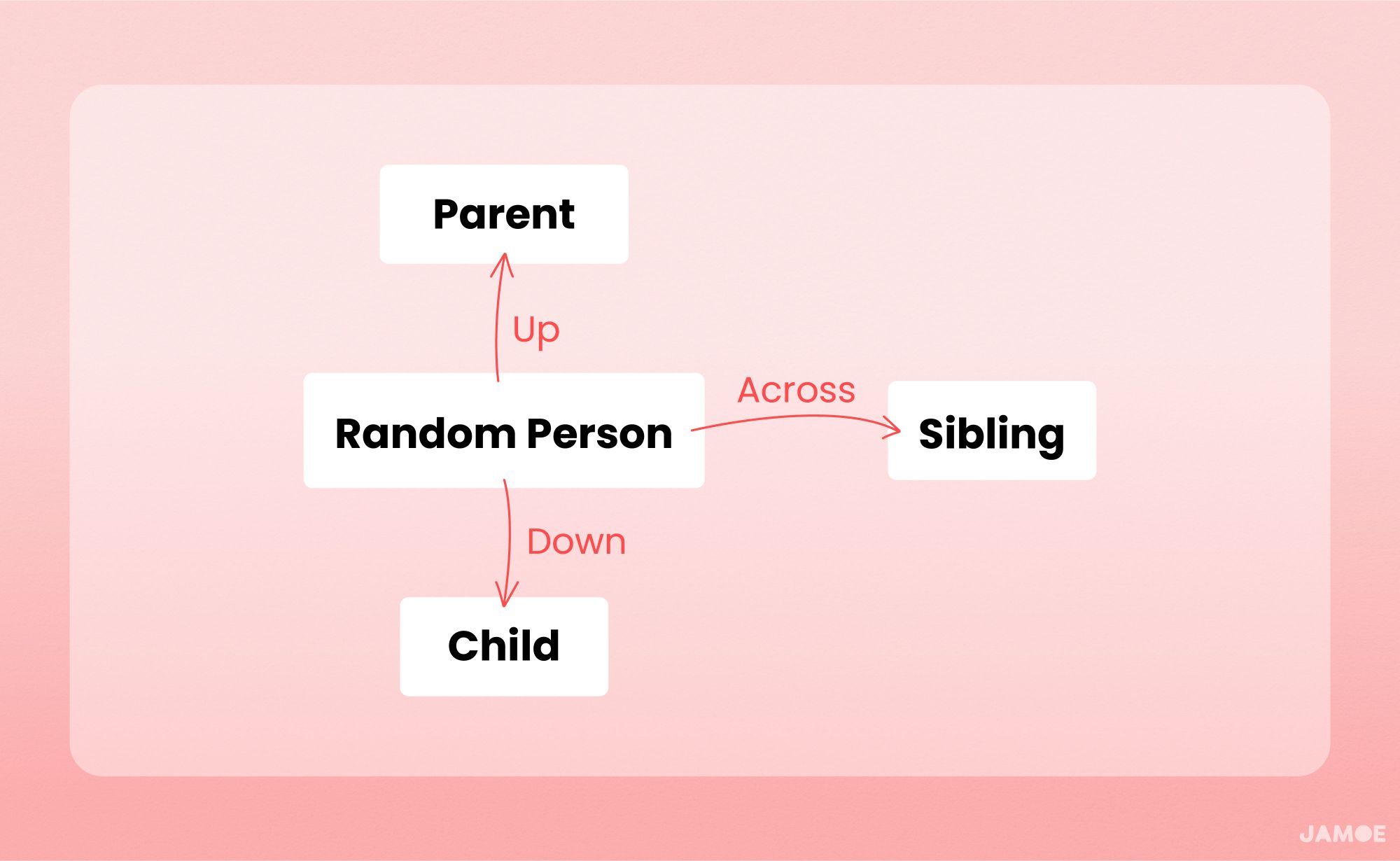
In the context of an idea, let's imagine you're reading about nuclear power. Your mind might apply the technique and imagine the following idea tree:
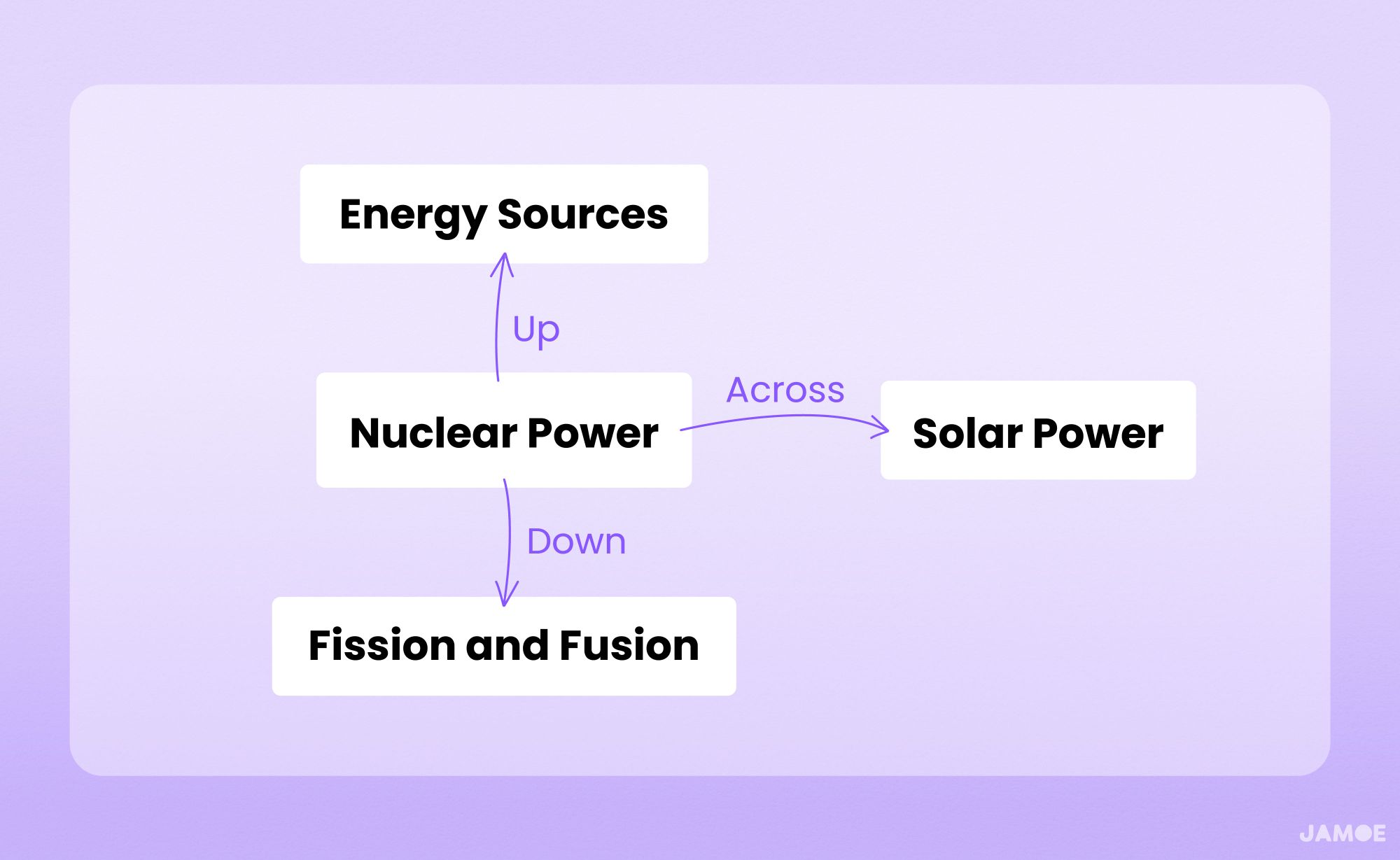
Unpacking nuclear power’s family tree, we have:
- Energy sources (Up) – nuclear power is an example of an energy source, making 'energy sources' the parent.
- Fission and fusion (Down) – these are the two types of nuclear power, making them children of the original idea.
- Solar power (Across) – being another sort of energy source makes this a sibling of nuclear power.
Each perspective puts a different frame around the idea of nuclear power, prompting a different question. For example:
- Energy source (Up) – why is nuclear not the dominant source of energy?
- Fission and fusion (Down) – what are the disadvantages of fusion over fission?
- Solar (Across) – how can nuclear and solar energy work together?
The Up, Down, and Across technique, and how it tilts your perspective for the better, can be summed up as:
- Up: the idea above – great for seeing the big picture and tying together multiple ideas.
- Down: the idea below – great for finding nuance.
- Across: the idea that rhymes – great for finding connections between topics and disciplines.
There is also the hidden fourth position: stay exactly where you are. That's the context-focused note described in the introduction. A context-focused note for nuclear power might be: 'What does Bill think is an underused source of energy?' – 'Nuclear power'.
We've found people like to give new techniques a test drive, so here are a few ideas to play around with. See our guide Up, Down, and Across idea trees in the footnotes[1]:
- Apples
- Yoga
- Triangles
Understanding the thought process underpinning the technique, we'll now unpick how we used it to write more thoughtful HQ&A Notes on Gates' book.
Up – The idea above
The chapter 'How We Plug In' focuses on how we could decarbonise our electricity sources. The chapter opens by exploring the pros and cons of solar and wind energy and offers some recommendations for making the best use of them.
Reading through the chapter, we wanted to take a note to remember the major factors one should consider when measuring the viability of different energy sources. The challenge was thinking of a comprehensive and concise question that would tie them all together.
Up was helpful here, as it prompted us to see the bigger picture. With it, we thought of a question that knitted together all the nuances:
Question: What three challenges make solar and on-shore wind necessary but not sufficient energy sources for achieving carbon zero? (BIT)
Answer:
- B – Battery: storing the energy is expensive, and without a technological breakthrough, it's impossible to achieve the scale required to power a town or city.
- I – Intermittency: sun and wind don't always shine and blow, but our energy demand is constant.
- T – Transmission: upgrading the US power grid at the federal level, and not state by state, is required and much cheaper. Difference between 15-30% Green Premium and 100%, respectively; moves energy from the highest solar/wind supply areas to those with the highest demand.
Highlight: 'Who would pay $5 [for a battery] to store [$0.05] worth of electricity' (p.77) '...supplement solar and wind with other ways to generate electricity... solar and wind can play a substantial role in getting us to [carbon] zero... we need them to' (p.81) '...If we don't upgrade our grid significantly and instead make each region do this... the Green Premium might not be 15 to 30 percent; it could be 100 percent or more.' (p.83)
Using the Up prompt, we thought of a neat mnemonic (BIT) that compresses six pages worth of ideas into a single HQ&A Note.
The acronym isn't destined for the history books, but it's a valuable way for us to remember the three key points and might be a technique you'd like to try when the moment's right.
Down – The idea below
A key metric used throughout the book is one of Gates' own making, the Green Premium. As it was foundational to his argument, we mentally flagged that taking a HQ&A Note on the concept would be worth the effort.
Down was the best-suited prompt for this, as it nudges the mind to find nuance and break ideas into small pieces.
This was valuable when taking a HQ&A Note on Green Premiums, as it forced us to drill into the factors that go into calculating the metric.
For context, a Green Premium is the price difference between a dirty option and a green alternative. So, if you have a dirty fuel priced at $10 per litre and a green fuel priced at $11 per litre, the green fuel is 10% more expensive. That makes the Green Premium also 10%.
The question prompted by thinking about Green Premiums from the Down perspective was:
Question: What two factors must you consider when calculating the Green Premium of green alternatives?
Answer:
- Step 1: Cost of Green Alternative = (1) Production cost of carbon-reduced alternative + (2) Cost of capturing any unavoidable carbon emissions.
- Step 2: Green Premium = Price difference between Dirty and Green Alternative expressed as a % of the Dirty option, e.g., $10 vs. $9 is Green Premium of -10% (the Green Alternative is cheaper).
Highlight: The average retail price for a gallon of jet fuel in the United States over the past few years has been around $2.22, while advanced biofuels for jets cost around $5.35 per gallon. The Green Premium is the difference between the two, which is $3.13, or an increase of more than 140 percent.' (p.59) '...we don't currently have a direct green equivalent in every case. There's no such thing as zero-carbon cement... We can [calculate the Green Premium] by conducting a thought experiment. "How much would it cost to just suck the carbon out of the atmosphere directly [using carbon capture]?"... [Using carbon capture] to solve the climate problem would cost at least $5.1 trillion per year, every year, as long as we produce emissions. That's around 6 percent of the world's economy.' (p.63)
Gates submits that we should focus on investing in research and development that make Green Premiums as low as possible. Ideally, that means getting prices equal to or less than their dirty alternatives for the sake of driving global adoption.[3]
Using the Down prompt, we were able to write a HQ&A Note that unpacks the blanket statement, 'Invest in research and development'. To achieve this, we had to read the text more closely, which forced a richer understanding of the levers we can pull to change the size of a Green Premium.
This exercise, and its value, is now neatly stored in our HQ&A Note for the future.
Across – The idea that rhymes
The one you'll use the least but will most often lead to your most creative and deepest thoughts: Across.
Comparing apples with other apples is dull. There are differences: colour, shape, size, taste, but they are all ultimately apples. Comparing apples with oranges is far more interesting. The unique qualities of each become starker, and how they’re similar isn’t dull but surprising.
That’s what we mean when recommending that you find the idea that rhymes and bake it into a question. Using the family tree framework from earlier, Across was likened to finding the original idea's sibling. Having explained that, we wanted to explore a more interesting application of Across: looking for the cousin.
Apples and oranges are siblings in the fruit family, and sitting these two ideas together may be the source of many curious questions. A (distant) cousin to the apple, however, might be the kookaburra.
Thinking of a question to tie these two ideas together, and illustrate a takeaway from what you’re reading, would be far harder, but pulling it off would also be far more intellectually thrilling.
When reading about nuclear energy, taking the Across route inspired a question that gets at the heart of nuclear energy’s problems, 'What can our attitudes towards nuclear power learn from the car industry?'.
Packed within the question are many of the obvious drawbacks to the technology but, by adopting this perspective, the resulting HQ&A Note also captures Gates’ interesting take as to why those drawbacks are superficial.
The question came from thinking about what other industries were unsafe, but we were able to make them less lethal and drive mass adoption through focus and further research. The car industry stood out as a great example, so we used this idea to inspire a question.
The outcome is an interesting insight – nuclear power isn't an untouchable technology, but one with the greatest potential to help us reach carbon zero:
Question: What can our attitudes towards nuclear power learn from the car industry?
Answer: Early cars were dangerous, but we systematically reduced the risks: seat belts, airbags, rear-view cameras. Today, nuclear power kills far fewer people than cars and fewer than any fossil fuel, and we’ve yet to even focus our efforts to take those risks down further. New simulated approaches to nuclear (TerraPower’s travelling wave reactor) offer carbon-free energy on a large scale: can run on nuclear waste (reduces bomb risk), underground (reduces the risk of attack), automated (removes human error).
Highlight: '[In 2018, MIT] analysed nearly 1,000 scenarios for getting to zero in the [US]; all the cheapest paths involved using a power source that’s clean and always available... like nuclear...(p.85)... Chernobyl... and Fukushima... put a spotlight on all the risks... instead of getting to work on solving those problems, we just stopped trying to advance the field.' (p.87)[4]
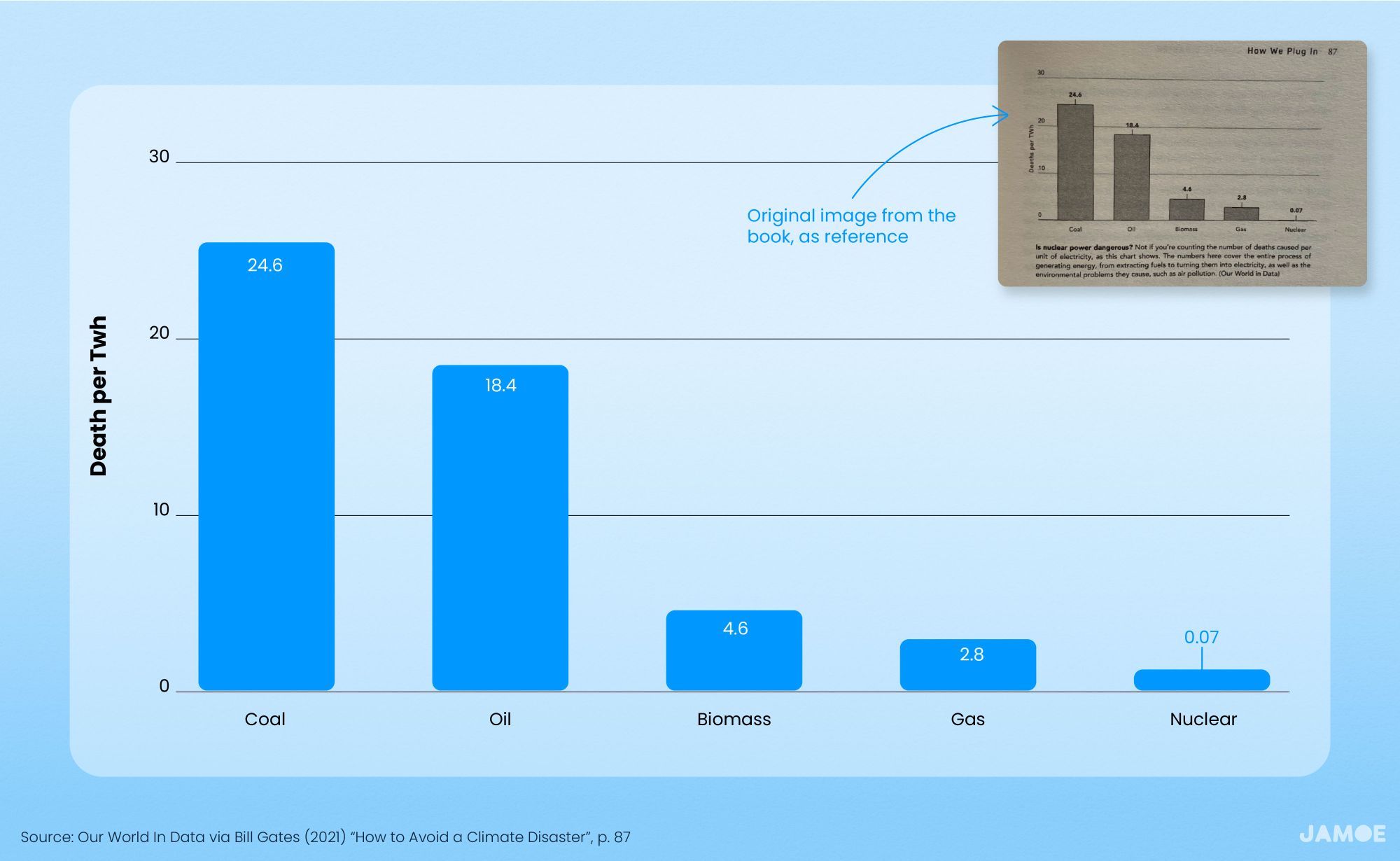
Using the Across technique to compare nuclear power to the car industry forced us to look at the topic with fresh eyes. For nuclear power, that meant being able to put the technology's cons into perspective and see that it can be a safe and significant source of carbon-free energy.
For your own exotic intellectual thrill, give the Across perspective a try the next time you’re taking notes.
Conclusion
HQ&A Notes train the mind to apply knowledge, which will help you better understand and digest what you're reading. The Up, Down, and Across technique takes things further by revealing more interesting angles to look at new ideas.
A bonus side-effect of using the technique is that you'll also develop a habit for seeing the big, little, and lateral picture of whatever problem you’re faced with.
The downside to the HQ&A technique is that it is designed for thinking slow. That means it's great for carving up ideas but can be too heavy-duty when you need to think fast, like during a lecture or when you're interviewing someone. That's where Jump Notes come in.
See the other articles in our Honest Notes note-taking series for a crisp summary of this technique and more.
Footnotes
[1] Apples – Up: Fruit; Down: Granny Smith; Across: Pears; Yoga – Up: Sports; Down: Aerial Yoga; Across: Tai Chi; Triangles – Up: Shapes; Down: Equilateral; Across: Icosahedron (20-sided polyhedron).
[2] If you'd like to read about Green Premiums in Gates' own words, he's published a great article on the topic here.
[3] Green Premiums are also helpful for spotting other forces preventing a green alternative from achieving mass adoption. For example, by tracking the Green Premium, we'll know when the price of the green alternative becomes equal to or less than the price of the dirty option. When this happens, it's reasonable to assume that the tipping point into mass adoption is around the corner. But what if nothing changes? That's a sign that other forces are preventing the adoption of the green alternative: regulatory, political, cultural, a lack of awareness. We can then redirect our efforts towards identifying and removing these chokepoints.
[4] Our kindred spirits at Kurzgesagt published a new nutshell video, Do We Need Nuclear Energy to Stop Climate Change?. Well, it's complicated, but if you're looking for clarity in the chaos, this 10-minute video is a great starting point. The video doubles as an astounding summary of the analysis provided in Gates’ How to Avoid a Climate Disaster, so if you wanted to read the book but don't have time, they've got you covered.
Read part four in our note-taking series.
